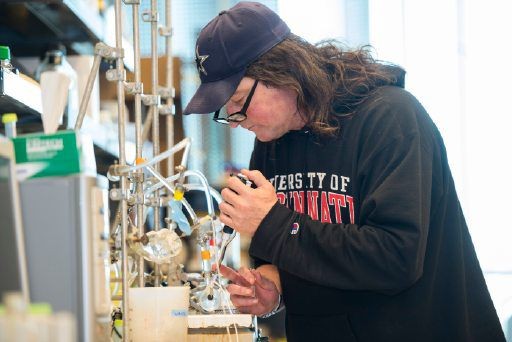
Atlanta Journal Constitution: Ointment kills antibiotic-resistant bacteria, promotes wound healing
Drug developed by UC researcher could be effective against 'superbugs'
Research at the University of Cincinnati College of Medicine may have added a weapon to hospitals’ bacteria fighting arsenal.
Using the topical drug called AB569 — a combination of acidified nitrite and ethylenediaminetetraacetic acid — promotes killing of antibiotic-resistant bacteria while enhancing the healing of wounds in a variety of burn injuries, the study found. The study was published in the journal Infection and Immunity.
The Atlanta Journal Constitution published a story on the research by Daniel Hassett, PhD, professor in the Department of Molecular Genetics, Biochemistry and Microbiology at the UC College of Medicine. Hassett patented AB569 in 2018.

Daniel Hassett, PhD, professor in the Department of Molecular Genetics, Biochemistry and Microbiology at the UC College of Medicine/Photo/Colleen Kelley/UC Creative + Brand
His research has found that AB569 kills virtually all pathogenic bacteria tested. Those bacteria are some of the most serious pathogens exhibiting multidrug resistance and enhanced virulence properties, according to the Centers for Disease Control and Prevention.
“Multidrug resistant bacteria, often called ‘superbugs,’ are an ever-burgeoning global health problem,” Hassett said. “As a result, there is a critical need to develop novel and effective antimicrobials for the prevention, treatment and eradication and healing of such wounds that are complicated by the most formidable pathogen of burn patients, known as MDR-PA. Injury severity is predominantly due to potentially lethal sepsis caused by MDR-PA.”
AB569 was first seen as a treatment for antibiotic-resistant organisms that cause pulmonary infections in patients with cystic fibrosis and chronic obstructive pulmonary disease, and many other opportunistic infections. In addition to tackling COPD and cystic fibrosis, AB569 may also be effective in addressing infections related to severe burns, urinary tract disorders, endocarditis and diabetes, Hassett said.
Hassett was also interviewed about this research by WVXU. See that coverage here.
Next Lives Here
The University of Cincinnati is classified as a Research 1 institution by the Carnegie Commission and is ranked in the National Science Foundation's Top-35 public research universities. UC's medical, graduate and undergraduate students and faculty investigate problems and innovate solutions with real-world impact. Next Lives Here.
Related Stories
Doctors prepare for surgeries with 3D-printed organs
April 11, 2025
Meteora3D, a Venture Lab-backed startup, helps surgeons better understand upcoming procedures by designing and developing quick-to-produce, 3D-printed anatomical models.
A 'night on the Serengeti' — in Cincinnati
Event: April 12, 2025 6:30 PM
University of Cincinnati and Village Life Outreach Project celebrate two decades of service to communities in rural Tanzania. The milestone will be honored on April 12 with a vibrant fundraiser titled “Village Life: Night on the Serengeti,” hosted at Cincinnati’s contemporary 21c Museum Hotel. The evening promises Tanzanian cuisine, art, live performance and, most importantly, a renewed call to sustain a mission that has transformed lives across continents.
How color cosmetics merge form with function
April 9, 2025
The University of Cincinnati's Kelly Dobos was a featured expert in a Cosmetics & Toiletries article explaining trends and innovations in color cosmetics.
